上海交通大学:《金融学原理》课程教学资源(练习与答案)Chapter Six The Analysis of Investment Projects
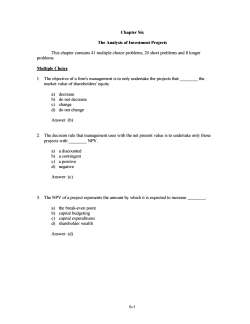
Chapter Six The Analysis of Investment Projects This chapter contains 41 multiple choice problems,20 short problems and 8 longer problems. Multiple Choice 1.The objective of a firm's management is to only undertake the projects that the market value of shareholders'equity. a)decrease b)do not decrease c)change d)do not change Answer:(b) 2.The decision rule that management uses with the net present value is to undertake only those projects with NPV. a)a discounted b)a contingent c)a positive d)negative Answer:(c) 3.The NPV of a project represents the amount by which it is expected to increase a)the break-even point b)capital budgeting c)capital expenditures d)shareholder wealth Answer:(d) 6-1
6-1 Chapter Six The Analysis of Investment Projects This chapter contains 41 multiple choice problems, 20 short problems and 8 longer problems. Multiple Choice 1. The objective of a firm's management is to only undertake the projects that ________ the market value of shareholders' equity. a) decrease b) do not decrease c) change d) do not change Answer: (b) 2. The decision rule that management uses with the net present value is to undertake only those projects with ________ NPV. a) a discounted b) a contingent c) a positive d) negative Answer: (c) 3. The NPV of a project represents the amount by which it is expected to increase ________. a) the break-even point b) capital budgeting c) capital expenditures d) shareholder wealth Answer: (d)
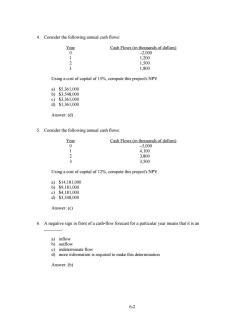
4.Consider the following annual cash flows: Cash Flows (in thousands of dollars) 0 -2,000 1,200 2 1,500 3 1,800 Using a cost of capital of 15%,compute this project's NPV. a)$5,361,000 b)$3,548,000 c)$3,361,000 d)$1,361,000 Answer:(d) 5.Consider the following annual cash flows: Year Cash Flows (in thousands of dollars) 0 -5,000 1 4,100 2 3,800 3 3,500 Using a cost of capital of 12%,compute this project's NPV. a)$14,181,000 b)$9,181,000 c)$4,181,000 d)$3.548.000 Answer:(c) 6.A negative sign in front of a cash-flow forecast for a particular year means that it is an a)inflow b)outflow c)indeterminate flow d)more information is required to make this determination Answer:(b) 6-2
6-2 4. Consider the following annual cash flows: Year Cash Flows (in thousands of dollars) 0 –2,000 1 1,200 2 1,500 3 1,800 Using a cost of capital of 15%, compute this project's NPV. a) $5,361,000 b) $3,548,000 c) $3,361,000 d) $1,361,000 Answer: (d) 5. Consider the following annual cash flows: Year Cash Flows (in thousands of dollars) 0 –5,000 1 4,100 2 3,800 3 3,500 Using a cost of capital of 12%, compute this project's NPV. a) $14,181,000 b) $9,181,000 c) $4,181,000 d) $3,548,000 Answer: (c) 6. A negative sign in front of a cash-flow forecast for a particular year means that it is an ________. a) inflow b) outflow c) indeterminate flow d) more information is required to make this determination Answer: (b)
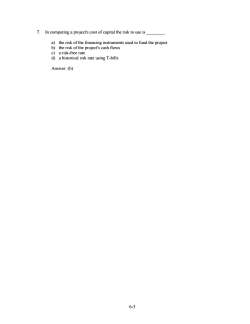
7.In computing a project's cost of capital the risk to use is a)the risk of the financing instruments used to fund the project b)the risk of the project's cash flows c)a risk-free rate d)a historical risk rate using T-bills Answer:(b) 6-3
6-3 7. In computing a project's cost of capital the risk to use is ________. a) the risk of the financing instruments used to fund the project b) the risk of the project's cash flows c) a risk-free rate d) a historical risk rate using T-bills Answer: (b)
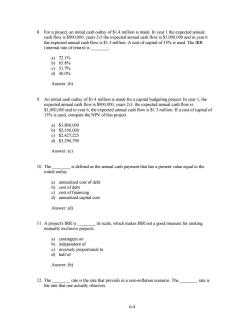
8.For a project,an initial cash outlay of $1.4 million is made.In year I the expected annual cash flow is $900,000,years 2-5 the expected annual cash flow is $1,000,000 and in year 6 the expected annual cash flow is $1.3 million.A cost of capital of 15%is used.The IRR (internal rate of return)is a)72.1% b)65.8% c)51.7% d)40.0% Answer:(b) 9.An initial cash outlay of $1.4 million is made for a capital budgeting project.In year 1,the expected annual cash flow is $900,000,years 2-5,the expected annual cash flow is $1,000,000 and in year 6,the expected annual cash flow is $1.3 million.If a cost of capital of 15%is used,compute the NPV of this project. a)$1,800,000 b)$2,100,000 c)$2,427,225 d$3,296,790 Answer:(c) 10.The is defined as the annual cash payment that has a present value equal to the initial outlay a)annualized cost of debt b)cost of debt c)cost of financing d)annualized capital cost Answer:(d) 11.A project's IRR is its scale,which makes IRR not a good measure for ranking mutually exclusive projects. a)contingent on b)independent of c)inversely proportional to d)half of Answer:(b) 12.The rate is the rate that prevails in a zero-inflation scenario.The rate is the rate that one actually observes. 6-4
6-4 8. For a project, an initial cash outlay of $1.4 million is made. In year 1 the expected annual cash flow is $900,000, years 2-5 the expected annual cash flow is $1,000,000 and in year 6 the expected annual cash flow is $1.3 million. A cost of capital of 15% is used. The IRR (internal rate of return) is ________. a) 72.1% b) 65.8% c) 51.7% d) 40.0% Answer: (b) 9. An initial cash outlay of $1.4 million is made for a capital budgeting project. In year 1, the expected annual cash flow is $900,000, years 2-5, the expected annual cash flow is $1,000,000 and in year 6, the expected annual cash flow is $1.3 million. If a cost of capital of 15% is used, compute the NPV of this project. a) $1,800,000 b) $2,100,000 c) $2,427,225 d) $3,296,790 Answer: (c) 10. The ________ is defined as the annual cash payment that has a present value equal to the initial outlay. a) annualized cost of debt b) cost of debt c) cost of financing d) annualized capital cost Answer: (d) 11. A project's IRR is ________ its scale, which makes IRR not a good measure for ranking mutually exclusive projects. a) contingent on b) independent of c) inversely proportional to d) half of Answer: (b) 12. The ________ rate is the rate that prevails in a zero-inflation scenario. The ________ rate is the rate that one actually observes

a)nominal,inflation b)real,expected c)nominal,real d)real,nominal Answer:(d) 6-5
6-5 a) nominal, inflation b) real, expected c) nominal, real d) real, nominal Answer: (d)
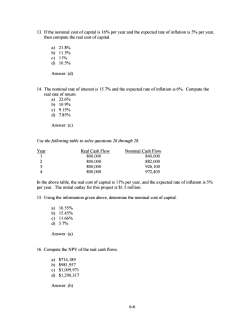
13.If the nominal cost of capital is 16%per year and the expected rate of inflation is 5%per year, then compute the real cost of capital. a)21.8% b)11.5% c)11% d)10.5% Answer:(d) 14.The nominal rate of interest is 15.7%and the expected rate of inflation is 6%.Compute the real rate of return. a)22.6% b)10.9% c)9.15% d)7.85% Answer:(c) Use the following table to solve questions 26 through 28. Year Real Cash Flow Nominal Cash Flow 1 800.000 840,000 2 800,000 882,000 3 800,000 926,100 4 800.000 972.405 In the above table,the real cost of capital is 11%per year,and the expected rate of inflation is 5% per year.The initial outlay for this project is $1.5 million. 15.Using the information given above,determine the nominal cost of capital. a16.55% b)15.45% c)11.66% d)5.7% Answer:(a) 16.Compute the NPV of the real cash flows. a)$714,189 b) $981,957 c) $1,009,971 d)$1,290,317 Answer:(b) 6-6
6-6 13. If the nominal cost of capital is 16% per year and the expected rate of inflation is 5% per year, then compute the real cost of capital. a) 21.8% b) 11.5% c) 11% d) 10.5% Answer: (d) 14. The nominal rate of interest is 15.7% and the expected rate of inflation is 6%. Compute the real rate of return. a) 22.6% b) 10.9% c) 9.15% d) 7.85% Answer: (c) Use the following table to solve questions 26 through 28. Year Real Cash Flow Nominal Cash Flow 1 800,000 840,000 2 800,000 882,000 3 800,000 926,100 4 800,000 972,405 In the above table, the real cost of capital is 11% per year, and the expected rate of inflation is 5% per year. The initial outlay for this project is $1.5 million. 15. Using the information given above, determine the nominal cost of capital. a) 16.55% b) 15.45% c) 11.66% d) 5.7% Answer: (a) 16. Compute the NPV of the real cash flows. a) $714,189 b) $981,957 c) $1,009,971 d) $1,290,317 Answer: (b)
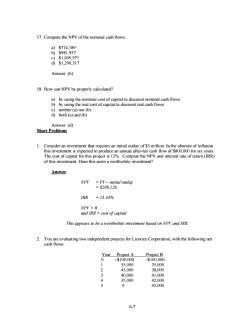
17.Compute the NPV of the nominal cash flows. a)$714,189 b)$981,957 c)$1,009.971 d)$1,290,317 Answer:(b) 18.How can NPV be properly calculated? a)by using the nominal cost of capital to discount nominal cash flows b)by using the real cost of capital to discount real cash flows c)neither (a)nor(b) d)both (a)and(b) Answer:(d) Short Problems 1.Consider an investment that requires an initial outlay of $3 million.In the absence of inflation this investment is expected to produce an annual after-tax cash flow of $800,000 for six years. The cost of capital for this project is 12%.Compute the NPV and internal rate of return (IRR) of this investment.Does this seem a worthwhile investment? Answer NPy PV-initial outlay =S289.126 IRR =15.34% NPV>0 and IRR cost of capital This appears to be a worthwhile investment based on NPV and IRR. 2.You are evaluating two independent projects for Licorice Corporation,with the following net cash flows: Year Project A Project B 0 -$100,000 -$100,000 55.000 35,000 2 45,000 38,000 3 40,000 41,000 X 35,000 42,000 5 0 45,000 6-7
6-7 17. Compute the NPV of the nominal cash flows. a) $714,189 b) $981,957 c) $1,009,971 d) $1,290,317 Answer: (b) 18. How can NPV be properly calculated? a) by using the nominal cost of capital to discount nominal cash flows b) by using the real cost of capital to discount real cash flows c) neither (a) nor (b) d) both (a) and (b) Answer: (d) Short Problems 1. Consider an investment that requires an initial outlay of $3 million. In the absence of inflation this investment is expected to produce an annual after-tax cash flow of $800,000 for six years. The cost of capital for this project is 12%. Compute the NPV and internal rate of return (IRR) of this investment. Does this seem a worthwhile investment? Answer: NPV = PV – initial outlay = $289,126 IRR = 15.34% NPV > 0 and IRR > cost of capital This appears to be a worthwhile investment based on NPV and IRR. 2. You are evaluating two independent projects for Licorice Corporation, with the following net cash flows: Year Project A Project B 0 –$100,000 –$100,000 1 55,000 35,000 2 45,000 38,000 3 40,000 41,000 4 35,000 42,000 5 0 45,000
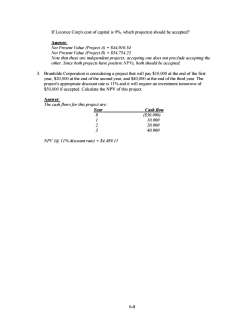
If Licorice Corp's cost of capital is 9%,which project(s)should be accepted? Answer: Net Present Value (Project A)=$44,016.54 Net Present Value (Project B)=$54,754.23 Note that these are independent projects;accepting one does not preclude accepting the other.Since both projects have positive NPVs,both should be accepted. 3.Brunhilde Corporation is considering a project that will pay $10,000 at the end of the first year,$20,000 at the end of the second year,and $40,000 at the end of the third year.The project's appropriate discount rate is 11%and it will require an investment tomorrow of $50,000 if accepted.Calculate the NPV of this project. Answer: The cash flows for this project are: Year Cash flow 0 (S50,000) 1 10.000 ) 20,000 U 40.000 NPV (11%discount rate)=S4,489.11 6-8
6-8 If Licorice Corp's cost of capital is 9%, which project(s) should be accepted? Answer: Net Present Value (Project A) = $44,016.54 Net Present Value (Project B) = $54,754.23 Note that these are independent projects; accepting one does not preclude accepting the other. Since both projects have positive NPVs, both should be accepted. 3. Brunhilde Corporation is considering a project that will pay $10,000 at the end of the first year, $20,000 at the end of the second year, and $40,000 at the end of the third year. The project's appropriate discount rate is 11% and it will require an investment tomorrow of $50,000 if accepted. Calculate the NPV of this project. Answer: The cash flows for this project are: Year Cash flow 0 ($50,000) 1 10,000 2 20,000 3 40,000 NPV (@ 11% discount rate) = $4,489.11
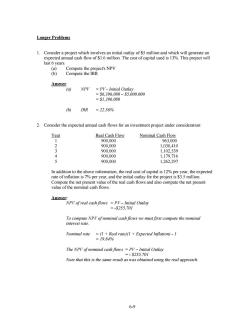
Longer Problems 1.Consider a project which involves an initial outlay of $5 million and which will generate an expected annual cash flow of $1.6 million.The cost of capital used is 13%.This project will last 6 years. (a) Compute the project's NPV (b) Compute the IRR Answer: a NPV =PV-Initial Outlay =$6396,080-$5,000,000 =$1,396,080 b IRR =22.56% 2. Consider the expected annual cash flows for an investment project under consideration: Year Real Cash Flow Nominal Cash Flow 900.000 963.000 2 900,000 1,030,410 J 900,000 1,102,539 4 900,000 1,179,716 5 900,000 1,262,297 In addition to the above information,the real cost of capital is 12%per year,the expected rate of inflation is 7%per year,and the initial outlay for the project is $3.5 million. Compute the net present value of the real cash flows and also compute the net present value of the nominal cash flows. Answer: NPV of real cash flows PV-Initial Outlay =-8255,701 To compute NPV of nominal cash flows we must first compute the nominal interest rate. Nominal rate =(1 Real rate)(1 Expected Inflation)-1 =19.84% The NPV of nominal cash flows PV-Initial Outlay =-8255,701 Note that this is the same result as was obtained using the real approach. 6-9
6-9 Longer Problems 1. Consider a project which involves an initial outlay of $5 million and which will generate an expected annual cash flow of $1.6 million. The cost of capital used is 13%. This project will last 6 years. (a) Compute the project's NPV (b) Compute the IRR Answer: (a) NPV = PV - Initial Outlay = $6,396,080 – $5,000,000 = $1,396,080 (b) IRR = 22.56% 2. Consider the expected annual cash flows for an investment project under consideration: Year Real Cash Flow Nominal Cash Flow 1 900,000 963,000 2 900,000 1,030,410 3 900,000 1,102,539 4 900,000 1,179,716 5 900,000 1,262,297 In addition to the above information, the real cost of capital is 12% per year, the expected rate of inflation is 7% per year, and the initial outlay for the project is $3.5 million. Compute the net present value of the real cash flows and also compute the net present value of the nominal cash flows. Answer: NPV of real cash flows = PV – Initial Outlay = -$255,701 To compute NPV of nominal cash flows we must first compute the nominal interest rate. Nominal rate = (1 + Real rate)(1 + Expected Inflation) - 1 = 19.84% The NPV of nominal cash flows = PV – Initial Outlay = - $255,701 Note that this is the same result as was obtained using the real approach
按次数下载不扣除下载券;
注册用户24小时内重复下载只扣除一次;
顺序:VIP每日次数-->可用次数-->下载券;
- 上海交通大学:《金融学原理》课程教学资源(练习与答案)Chapter Five Household Savings and Investment Decisions.pdf
- 上海交通大学:《金融学原理》课程教学资源(练习与答案)Chapter Four Allocating Resources Over Time.pdf
- 上海交通大学:《金融学原理》课程教学资源(练习与答案)Chapter Three Managing Financial Health and Performance.pdf
- 上海交通大学:《金融学原理》课程教学资源(练习与答案)Chapter Two Financial Markets and Institutions.pdf
- 上海交通大学:《金融学原理》课程教学资源(练习与答案)Chapter One Financial Economics.pdf
- 上海交通大学:《国际政治经济学的源与流》选修课程PPT教学课件_自由主义.ppt
- 上海交通大学:《国际政治经济学的源与流》选修课程PPT教学课件_课程简介与绪论(陈鹏).ppt
- 上海交通大学:《国际政治经济学的源与流》选修课程PPT教学课件_现实主义(下).ppt
- 上海交通大学:《国际政治经济学的源与流》选修课程PPT教学课件_现实主义(上).ppt
- 上海交通大学:《国际政治经济学的源与流》选修课程PPT教学课件_建构主义.ppt
- 《公司金融》课程教学资源(阅读材料)洛阳钼业定增折价率逾 45%,8家基金认购180亿元.docx
- 《公司金融》课程教学资源(阅读材料)南京中华汽车零部件公司.pdf
- 《公司金融》课程教学资源(阅读材料)斯斑萨公司.pdf
- 《公司金融》课程教学资源(学习资料)The American economic Revlew.pdf
- 上海交通大学:《公司金融(理财)Corporate Finance》教学资源(课程讲义)Lecture 05 债券估值.ppt
- 《公司金融(理财)Corporate Finance》课程教学资源(阅读材料)六大财务公式——投资项目财务可行性分析.docx
- 上海交通大学:《公司金融(理财)Corporate Finance》教学资源(课程讲义)Lecture 08 风险收益与资本成本(套利定价理论与资本成本).ppt
- 上海交通大学:《公司金融(理财)Corporate Finance》教学资源(课程讲义)Lecture 07 收益和风险——资本资产定价模型.ppt
- 上海交通大学:《公司金融(理财)Corporate Finance》教学资源(课程讲义)Lecture 04 资本预算实务(投资决策——风险分析、实物期权和资本预算案例).ppt
- 上海交通大学:《公司金融(理财)Corporate Finance》教学资源(课程讲义)Lecture 03 投资决策——净现值与投资评价的其他方法(NPV-IRR和增量现金流).ppt
- 上海交通大学:《金融学原理》课程教学资源(练习与答案)Chapter Seven Principles of Market Valuation.pdf
- 上海交通大学:《金融学原理》课程教学资源(练习与答案)Chapter Eight Valuation of Known Cash Flows:Bonds.pdf
- 上海交通大学:《金融学原理》课程教学资源(练习与答案)Chapter Nine Valuation of Common Stocks.pdf
- 上海交通大学:《金融学原理》课程教学资源(练习与答案)Chapter Ten Principles of Risk Management.pdf
- 上海交通大学:《金融学原理》课程教学资源(练习与答案)Chapter Eleven Hedging, Insuring, and Diversifying.pdf
- 上海交通大学:《金融学原理》课程教学资源(练习与答案)Chapter Twelve Portfolio Opportunities and Choice.pdf
- 上海交通大学:《金融学原理》课程教学资源(练习与答案)Chapter Thirteen Capital Market Equilibrium.pdf
- 上海交通大学:《金融学原理》课程教学资源(练习与答案)Chapter Fourteen Forward and Futures Markets.pdf
- 上海交通大学:《金融学原理 Financial Economics》教学资源(课程讲义PPT)Lecture 01 Introduction of Financial Economics(唐宗明).ppt
- 上海交通大学:《金融学原理 Financial Economics》教学资源(课程讲义PPT)Lecture 02 Financial Markets and Institutions.ppt
- 上海交通大学:《金融学原理 Financial Economics》教学资源(课程讲义PPT)Lecture 03 Managing Financial Health and Performance.ppt
- 上海交通大学:《金融学原理 Financial Economics》教学资源(课程讲义PPT)Lecture 04 Allocating Resources Over Time.ppt
- 上海交通大学:《金融学原理 Financial Economics》教学资源(课程讲义PPT)Lecture 05 Household Saving and Investment Decisions.ppt
- 上海交通大学:《金融学原理 Financial Economics》教学资源(课程讲义PPT)Lecture 06 The Analysis of Investment projects(capital budgeting).ppt
- 上海交通大学:《金融学原理 Financial Economics》教学资源(课程讲义PPT)Lecture 07 Principles of Market Valuation.ppt
- 上海交通大学:《金融学原理 Financial Economics》教学资源(课程讲义PPT)Lecture 08 Valuation of Known Cash Flows:Bonds.ppt
- 上海交通大学:《金融学原理 Financial Economics》教学资源(课程讲义PPT)Lecture 09 Valuation of Common Stocks.pdf
- 上海交通大学:《金融学原理 Financial Economics》教学资源(课程讲义PPT)Lecture 09 Valuation of Common Stocks.ppt
- 上海交通大学:《金融学原理 Financial Economics》教学资源(课程讲义PPT)Lecture 10 Principles of Risk Management.ppt
- 上海交通大学:《金融学原理 Financial Economics》教学资源(课程讲义PPT)Lecture 12 Portfolio Opportunities and Choice.ppt
